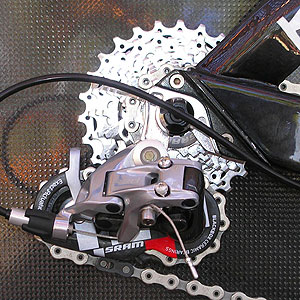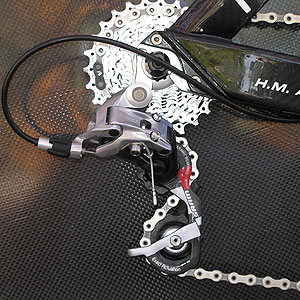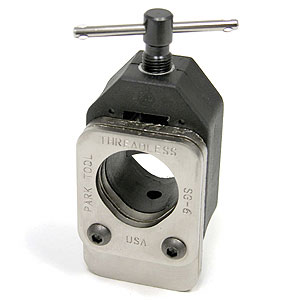The correct length of your chain

Nowadays, changing the cogset to match the race course does not come with the same urgency it used to. When I started racing, the standard was a 5-speed cluster. I rode with a 13-21 in the rear, that is, 13-15-17-19-21. There were no 12-tooth cogs, there were no 6-speed freewheels. We rode with 52×42-teeth chainrings. Some racers had 13-23 freewheels: 13-15-17-20-23. I considered them wimps. Who could possibly need a 23-tooth cog? "Just grind the MFer" (I used this unfortunate language back then). Everything that came after this—each successive cog, new chainring sizes—all seemed to me silly. Finally, this newer generation of riders were such pantywaists that we had to widen the bike's rear end to fit all these granny gears.
Imagine if a bike racer from the late 70s crashed and fell into a coma, only to awaken this year to find not 5, 6, 7, or even 8 gears on the backs of bikes, but 11! Well, 10, but if he stays asleep for a few more months, he'll wake up to 11.
This certainly seems like a lot of gears, it's true, but this has given us some opportunities. With today's 10-speed gearing, we can ride Shimano cassettes in the following configurations: 11-21; 11-23; 12-21; 12-23; 12-25; 12-27. That 12-21 is what we call a straight-block: all cogs are one tooth apart from the next in the series. A straight block is what you'd want on flat terrain.
On hilly terrain, though, you'd want some cogs with a lot of teeth. Perhaps you might choose that 12-25, or even the 12-27. What some have found maddening, though, is that Shimano does not make an 11-27. Why not, since you have 10 gears to work with, and since Shimano's standard-cage Dura Ace rear derailleur can handle a fairly wide range of total teeth? By "total teeth" I refer to the range dictated by the size of the rear derailleur's cage. That cage, which houses the higher and lower pullies, sucks up the excess chain when you're in gears featuring not very many teeth, for example, the small chainring in front and a smaller cog in back. Were you riding a 12-27 with a 53×39 crank, the total teeth represented there is 29 teeth, 15 in the rear plus 14 in the front. Shimano's derailleurs can easily handle 30 total teeth, and this assumes riding in the small ring and small cog, and/or the big ring and big cog, generally considered a no-no.
SRAM does make 11-tooth-to-granny gear 10-speed cassettes. It makes 11-26 and even 11-28. These slip right onto Shimano cassettes and work acceptably well on Shimano drivetrains. When would you want a cassette like this? Two possibilities. One is where you have both steep uphills and gentle descents. Wildflower Triathlon's long course is an example that comes to mind. More likely is when climbing power and lower gears is really a priority to you, and you've chosen compact gearing. Typical with a crank made in this style is to have chain rings featuring 50×36 teeth, or even 50×34.
If a 50-tooth chainring is what you've got as your outer, that 11- tooth cog may come in handy on those gently sloping descents. For this reason, depending on the course, either an 11-21 or an 11-26 might be in order, depending on the profile of the course.
In other words, yes, with 10 cogs on the back, the urgency to change cassettes per the race topography is not as great. But, racing triathlons in the aero position in a steep config does require riding that high cadence, so gearing is again thrust onto center stage.

All this is preparatory for telling you why it is you want to choose your chain length with care. Specifically, you want it to be as long as possible. Don't try to shorten the chain in order to save weight. You specifically want to avoid forcing the rear derailleur to work beyond its limit, and that limit is generally considered to have been reached when the lower pulley is directly below the upper. Best if that lower pulley is never in front of the upper.
In the case of the photo at the top of this article, you'll note that the lower pulley is sitting almost directly behind the upper. That's how your derailleur should look when your chain is in a gear using the fewest total teeth. On paper, the fewest number of teeth is achieved when your chain is on the smallest cog (an 11t or 12t cog), and the small (inner) chainring. But, as previously stated, that gear is not kosher to ride.
Shimano maintains you can ride its drivetrain in lo-lo or hi-hi. Nevertheless, in the case of the photo at the top of the article, the chain length is chosen with the chain sitting on the small ring and the second-to-smallest cog (I maintain lo-lo is still a no-no). You'll note there is some tension in the chain, and the chain must not rub on the upper pulley's chain guard. That's how you determine the chain's proper length, and it yields the longest chain available to you.
The photo just above shows that same chain coursing through the pulleys of a SRAM Red derailleur, with the chain on the 53-tooth chainring and on the third cog down from the top. This is an 11-26 freewheel, meaning that third cog down is a 21-tooth. The bike can customarily be ridden on the second cog from the top, which is a 23t, but as you can see the pulleys are on top of each other even with the bike in a 53×21. So, were this chain any shorter, you'd be hard pressed to efficiently ride this cassette on this bike with this chain.
This ability to move from a close-ratio cassette to one with a wide- ratio, without changing your chain, requires you mount your new chain using this method.



